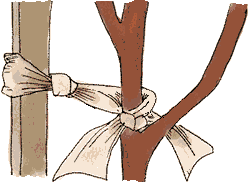 | ||
 | ||
Supporting PlantsSome plants need to be supported or staked because they can easily be blown over by the wind or because they get top-heavy with blossoms or fruit. Staking a plant while it's growing is easier because the branches are a little more flexible and less likely to break than once they are fully grown. Plant StakesYour stakes should be about a third longer than the mature plant is expected to reach. You can use long wooden, plastic, or bamboo poles or even old tent poles if you have any. Whatever you decide to use, it should be sturdy enough that you can push about a third of it into the ground, close to the stem of your plant.
Plant TiesYou can use anything soft and pliable to gently tie your plants to the stakes:
Use them every 10 to 12 inches (25 to 30 cm) along the stem to support the weight of the maturing plant. Plant CagesFor bushy plants that produce a lot of heavy fruit, like tomatoes, you can buy wire cages that surround the whole plant. Put a cage over each young seedling, and it will grow up inside the cage. The branches will poke through the bars, which will support them while they bear fruit. It also keeps the fruit off the ground where they could get damaged or eaten by bugs. Trellises and ArborsIf you have decorative plants that like to climb, you can train them to grow up a trellis or arbor. Gently tie the lead stem to the bottom uprights and tie some of the branches out toward the edges of the supports. Plants that have tendrils or clingers will wind themselves around the supports, and you just need to guide them where you want them to fill in. The plant will eventually spread out and cover the whole trellis. Bean Poles and HousesPlants that grow very tall, like runner beans, need to have a trellis to climb up so they don't lay on the ground and get eaten or damaged. You can make a support frame from lightweight bamboo stakes about 5 feet (1.5 m) in length. Select which plant will be at each end of your support structure and push a stake into the soil on each side of it, about 2 feet (60 cm) apart. Cross the tops of the stakes and use some twine to tie them tightly together about 6 inches (15 cm) down from the top. These are your 'uprights.' Make your next upright about 3 feet (1 m) along the row and every 3 feet after that until you reach the end of your row. Lay a long pole between the tops of the uprights so they rest in the cross-over at the top of the uprights. Tie them in place so they don't slide. The beans will love to climb up the poles and along the supports. The blooms will look terrific, and you will be able to pick the ripened beans easily. An added bonus is that ground bugs won't bother them as much, and you will be able to see any pests that you have to remove. If you feel very ambitious, you could create a 'bean house' that you can actually sit inside by making your supports in a square shape and leaving an opening for a door. By summer's end, you'll have a secret hiding place right in your garden. | ||
| ||
